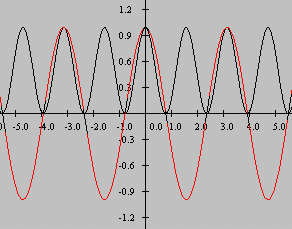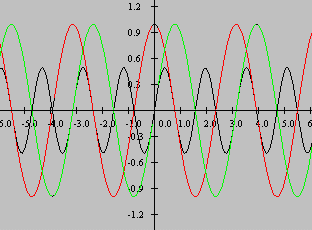| << Chapter < Page | Chapter >> Page > |
| Figure 11. Plot of cos(x) and cos(x)*cos(x). |
|---|
 |
The red curve in Figure 11 shows the function cos(x), and the black curve shows the function produced by multiplying cos(x) by cos(x).
If you sum the values of the black curve in Figure 11 over an even number of cycles, the sum will not be zero. Rather, it will be a positive, non-zero value.
Now refer back to the expression for Real(F) in Figure 6 . The real part of the transform is computed by multiplying the time series by a cosine functionhaving a particular frequency and computing the sum of products. If that time series contains a cosine component with the same frequency as the cosinefunction, that component will contribute a non-zero value to the sum of products. Thus, the real part of the transform at that frequency will not bezero.
Now consider the time series for case 3 in Figure 9 , which is the product of a sine function and a cosine function having the same frequency. The result ofcomputing this product is shown graphically in Figure 12
| Figure 12. Plot of sin(x), cos(x), and sin(x)*cos(x). |
|---|
 |
The red curve in Figure 12 shows the function cos(x), and the green curve shows the function sin(x). The black curve shows the function produced bymultiplying sin(x) by cos(x).
If you sum the values of the black curve over an even number of cycles, the sum will be zero.
Therefore, referring back to Figure 6 , we see that
The Real(F) computation in Figure 6 does not produce a non-zero output due to a sine component in the time series having the same frequency. The Imag(F)computation in Figure 6 does not produce a non-zero output due to a cosine component in the time series having the same frequency.
Thus, at a particular frequency, the existence of a cosine component in the target time series produces the real output, and the existence of a sinecomponent in the target time series produces the imaginary output.
In reality, the sinusoidal components that make up a time series will not usually be sine functions or cosine functions. Rather, they will be sinusoidalcomponents having the same shape as a sine or cosine, but not having the same value at zero as either a sine function or a cosine function. However, it can beshown that a general sinusoidal function can always be represented by the sum of a sine function and a cosine function having different amplitudes and the samefrequency.
(A proof of the above statement is beyond the scope of this module. You will simply have to accept on faith that a general time series can berepresented as the sum of a potentially infinite number of sine functions and cosine functions of different frequencies and different amplitudes. Itis these cosine and sine functions that constitute the real and imaginary components of the complex frequency spectrum.)

Notification Switch
Would you like to follow the 'Digital signal processing - dsp' conversation and receive update notifications?